Fore! TURF winners use mini-golf to explore present-day city life in L.A.
By Bustler Editors|
Tuesday, Nov 17, 2015
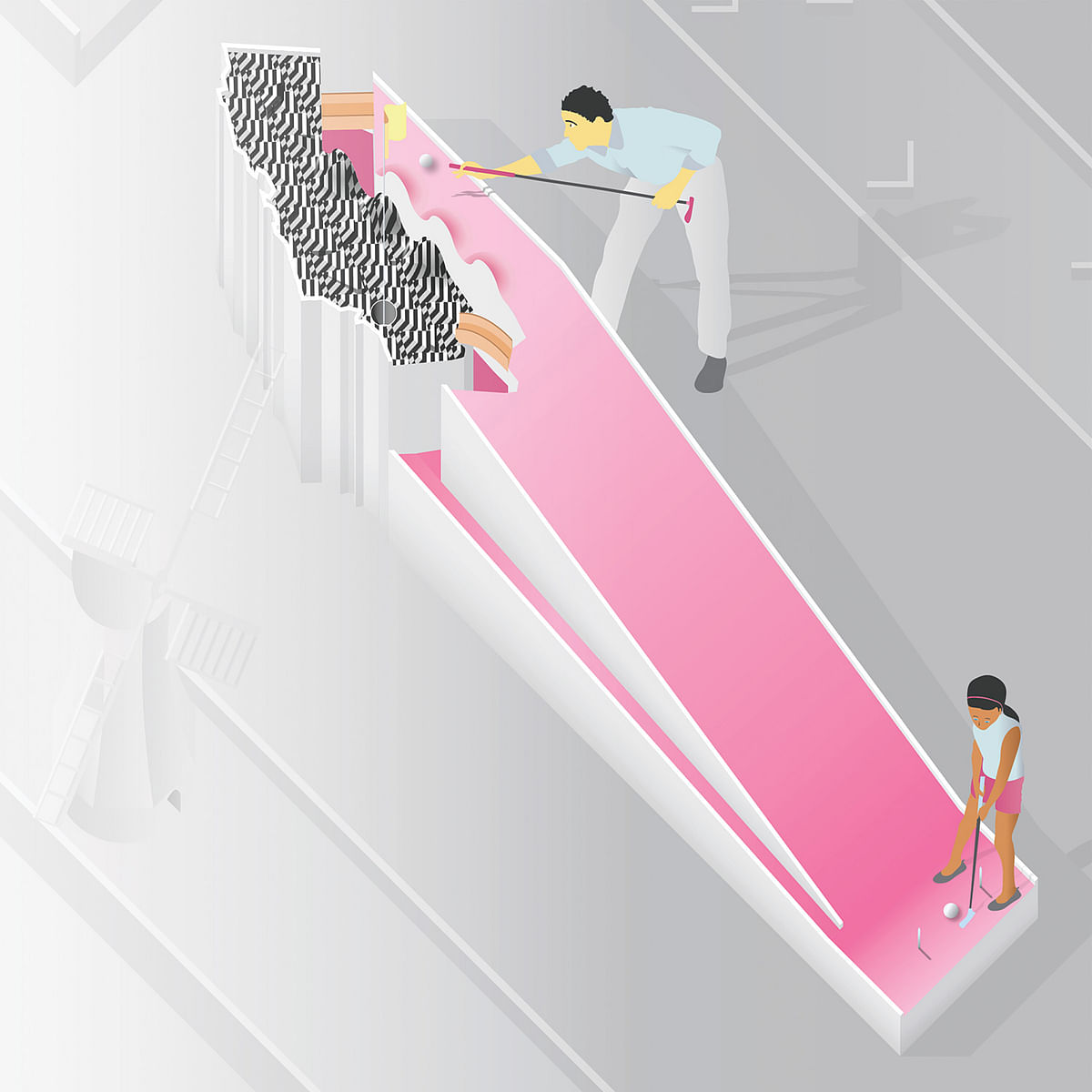
Related
What could make investigating urban life in Los Angeles as fun as mini-golf can? Locally based Materials & Applications did just that in their TURF: A Mini-Golf Project competition, which explores the meanings of "terrain" and "territory" in L.A. through the architecture of mini-golf.
M&A invited architects, designers, and artists to conjure up a single architectural mini-golf course that explores a current L.A. condition, like the ongoing drought and lawns, housing typologies and identity, parking and traffic, and so on. At the end of the competition, nine winners and six honorable mentions were selected.
Sounds like the perfect opportunity to play some mini-golf, huh? Well, take note — the winning entries will be constructed as a fully operating mini-golf course in L.A. for three weeks in early Spring 2016. The public will get to play on the temporary course Thursday through Sunday.
Take a peek at the winning designs below.
club LA
by Andrea Kamilaris, Brian Koehler, Drew Stanley
"Obstacles: Los Angeles is diverse. A multitude of networks and users pose challenges to those hoping to define its identity. However, that which segregates Los Angeles into the various neighborhoods, beaches, and districts also unites the entire city as one. Each of the following proposed obstacles seeks to disrupt the player in different ways, but they’re for the same cause. While each obstruction is unique to itself, their coherence becomes apparent when cloaked by an overarching graphic. What may seem simple quickly becomes troublesome. As you can see, this particular hole will require additional talent beyond your miniature golf skills. Should you try to shoot the gap, or play it safe and go for the landing on the right? The choice is yours.
Graphic: A dazzle pattern applied to the surface lends an additional obstacle; a veil of deception that masks the playground that is Club LA. From this particular angle, the pattern is brought to the foreground, obscuring any potential obstructions that might await the player. However, as one moves around the field of play, deformations in the pattern begin to expose the truth."

Look out for exhibited works by:
- Andrew Kovacs
- Bureau Spectacular (Jimenez Lai)
- CODA (Caroline O'Donnell)
- First Office (Anna Neimark + Andrew Atwood)
- MILLIØNS (John May + Zeina Koreitem)
- MOS Architects (Hilary Sample + Michael Meredith)
- Norman Kelley (Carrie Norman + Thomas Kelley)
- PARA Project (Jon Lott)
- Pita + Bloom (Florencia Pita + Jackilin Hah Bloom)
- SO-IL (Florian Idenburg + Jing Liu)
- WOJR (William O'Brien Jr.)

Look out for exhibited works by:
- Andrew Kovacs
- Bureau Spectacular (Jimenez Lai)
- CODA (Caroline O'Donnell)
- First Office (Anna Neimark + Andrew Atwood)
- MILLIØNS (John May + Zeina Koreitem)
- MOS Architects (Hilary Sample + Michael Meredith)
- Norman Kelley (Carrie Norman + Thomas Kelley)
- PARA Project (Jon Lott)
- Pita + Bloom (Florencia Pita + Jackilin Hah Bloom)
- SO-IL (Florian Idenburg + Jing Liu)
- WOJR (William O'Brien Jr.)
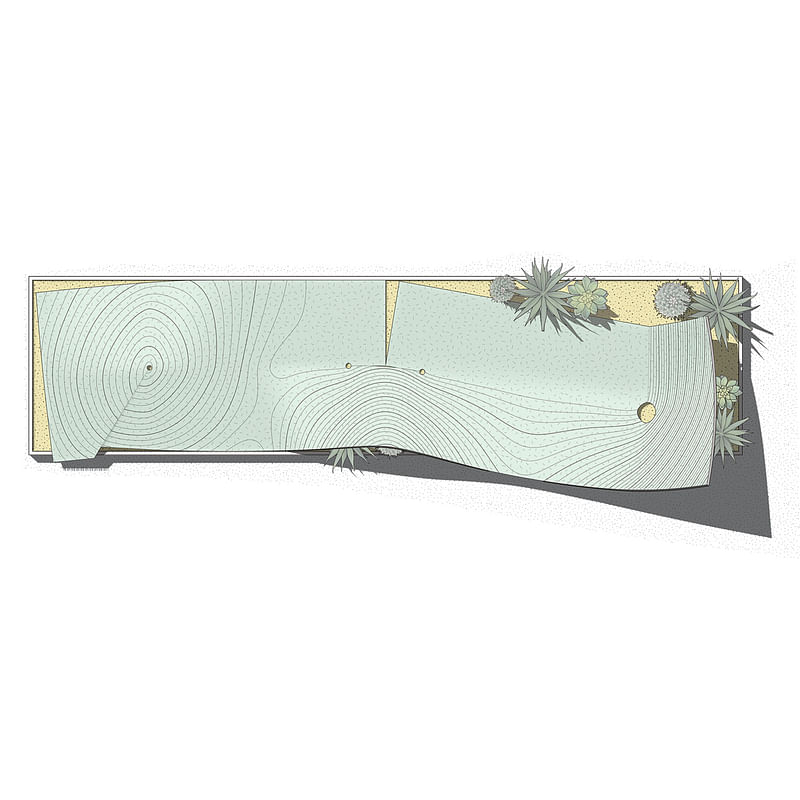
Putt-to-Fit
by Knowhow Shop (Justin Rice + Kagan Taylor with Jacob Van Vranken, Evan Brown, Garth Britzman)
"Putt-to-Fit is a mini-golf challenge that uses the plywood tailoring operations developed by Ray and Charles Eames for their iconic leg splint and furniture, applying them on the scale of landscape to tailor a strip of lawn: cutting out darts and stitching it together to create an amplified playing surface that does not rely on obstacles in the landscape to enhance game play, but instead uses the landscape itself. The voids and openings left by the tailoring operations become “sand traps,” exposing an arid and drought tolerant surface below: a landscape more in keeping with the native Southern California ecology than the gold courses and lawns that have been imposed on it. Putt-to-Fitt can be seen as altering a landscape that no longer fits, like one might alter a garment, turning a traditional water thirsty putting green into a challenging mini-golf hole surrounded by native landscaping. The “terrain and territory” of the project is extended to LA design history and the innovative fabrication techniques that continues to be developed within the current culture of design and architecture."
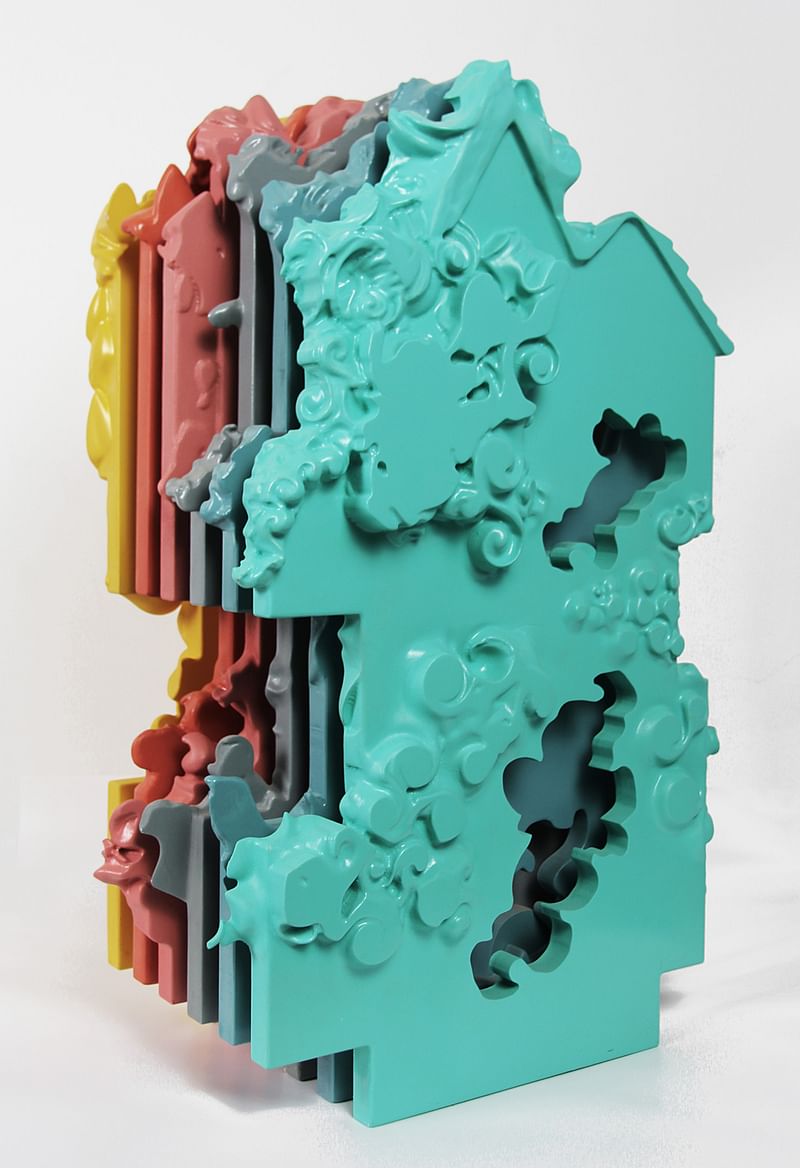
"With each bust, the exhibitors articulate their positions and their interpretations by the ways in which they reaffirm, undermine, or disregard such conditions. Because a bust is traditionally articulated through a subtractive process rather than an assembled construct, the various alternative methods employed by each exhibitor in the production of their bust suggests more general positions regarding architectural form.
In a broader context, the spectrum of invited architects/artists will exhibit a wide breadth of representation and fabrication techniques that is currently permeating the trans-disciplinary discourse of art and architecture through the inspiration of the classical bust."

"With each bust, the exhibitors articulate their positions and their interpretations by the ways in which they reaffirm, undermine, or disregard such conditions. Because a bust is traditionally articulated through a subtractive process rather than an assembled construct, the various alternative methods employed by each exhibitor in the production of their bust suggests more general positions regarding architectural form.
In a broader context, the spectrum of invited architects/artists will exhibit a wide breadth of representation and fabrication techniques that is currently permeating the trans-disciplinary discourse of art and architecture through the inspiration of the classical bust."
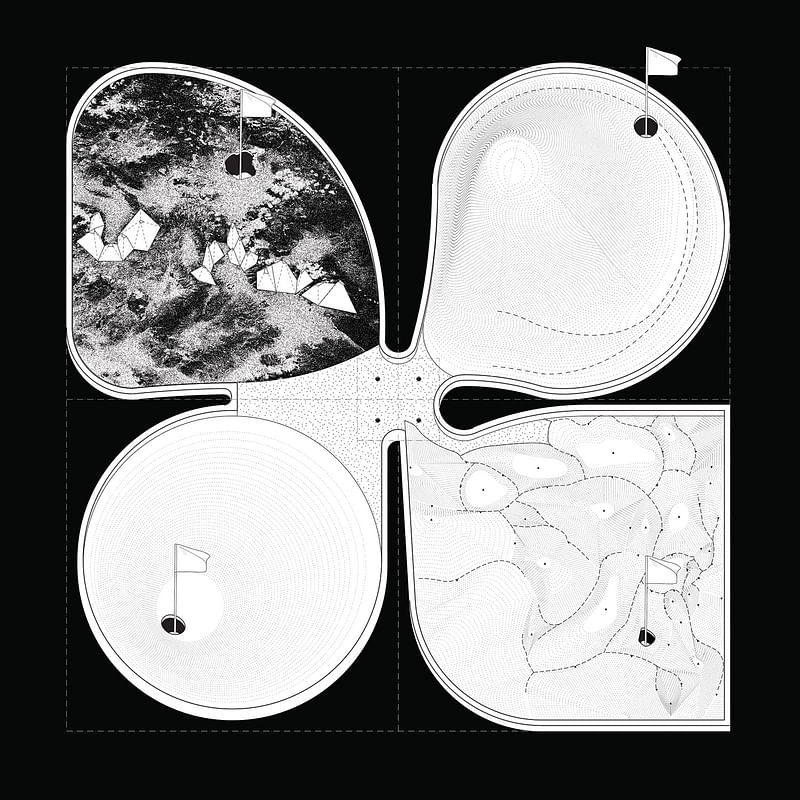
Terrains
by TAG-LA (Angel Gonzalez + Trenman Yau)
"Los Angeles is bounded by its terrain, with the ocean to the South and West and mountain ranges to the North and East. The city navigates through its physical geography, which changes in climate and elevation. It is both flat and hilly, both natural and artificial, for Los Angeles, the terrain provides the greatest obstacle. The mini golf obstacle is set in a 10 feet by 10 feet boundary, each quadrant of the course provides a distinct landscape. The player starts in the middle, aiming for one of the target in each of the four corners. Terrain is just like Los Angeles, giving players a choice over which terrain to conquer."
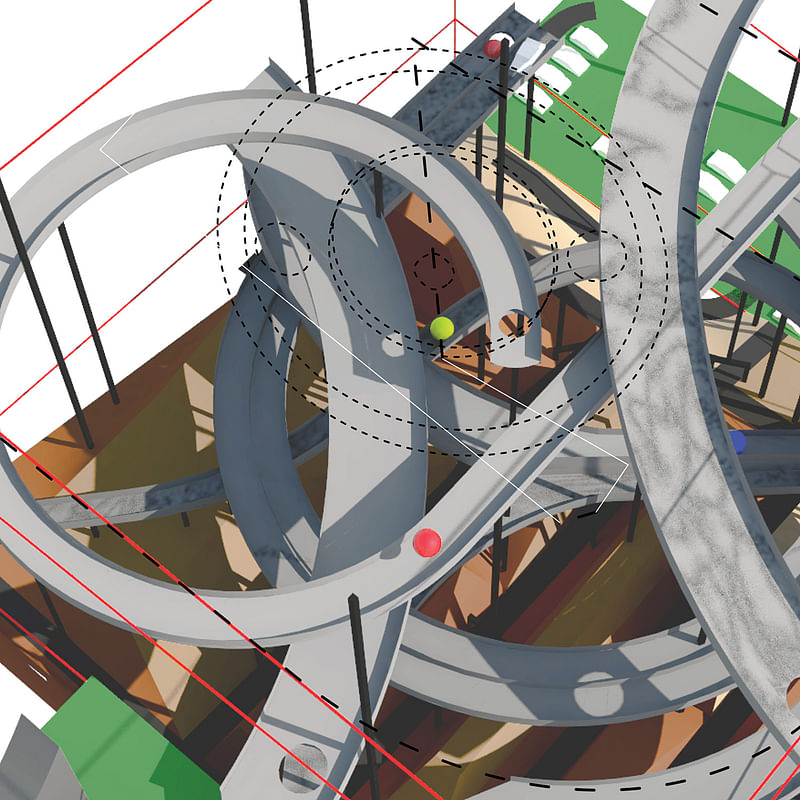
Driving DE(rang)ED
by La Fabrica (Karni Hadidian, Luis Ixta, Kristine Edinchikyan, Oscar Corletto)
"It’s just another LA day, you have somewhere to be but as luck would have it, you’re stuck in traffic, gridlocked and feeling further from our destination than when you first started the arduous journey. Then, suddenly and seemingly out of nowhere, traffic lets up, and you deftly maneuver into the opening. Uttering silent prayers, you are hoping that this lane, this wannabe wormhole, will magically take you to your destination. Mirroring the frustrating experience along the notorious freeways of Los Angeles, DRIVING DE(rang)ED seeks to bring an alternative experience to the commuter, a happier and more joyful adventure. Like a maze, the overpasses, underpasses, and roads take the golf ball—your vehicle—through five different levels. Never taking the same route twice, there is only one route to your final destination. If you’re lucky, you will find that magical wormhole and get the hole in one.
The object of this particular hole is hitting the ball from the onramp into the freeway ramp maze and attempting to guide it close to the hole but the difficulty lies in the ran- domness of its path. This adds to the mystery of the path traveled similar to how we never know what may occur or what we will encounter on the open road. The player is elevated at the top of a starting platform from where they will hit the ball into play and there is a small steering wheel located at the top which operates the Wormhole and a few of the interactive pieces in the game which allow for the route to change and adapt.
DRIVING DE(rang)ED is a mash-up of Mini-Golf, Skee-ball, Plinko, and a bit like a Labyrinth. There are a total of five levels that drop the ball into different sections of the Los Angeles Highways. Some of the paths will lead the ball to fall out of play and end the game or allow the player to restart its path of travel. DRIVING DE(rang)ED is a game of chance and it reminds the player to consider their routine commutes and the multiple variables that could and do occur in their lifetime of transportation. As travelers in life we never take the same path twice, no matter how much we try, and there lies the mystery of where you will end up."

The Electric Palm Tree Turbine House
by Ordinary Architecture (Elly Ward and Charles Holland)
"Our proposal brings together a number of themes and ideas about Los Angeles in an absurd architectural object that in turn pays homage to one of the traditional typologies of mini-golf itself — the windmill. Part wind turbine, part palm tree and part residential tower, the object addresses issues of densification + verticality; renewable technologies and sustainability; and iconicism + symbolism. It plays with images of a future LA that is denser, taller and more environmentally responsible whilst also reveling in the city’s historic iconography.
The object is both serious and playful, cartoonish and critical. In Venturian terms it is definitely a ‘duck’ albeit a heavily decorated one. It is also performative, offering the joy of an architecture that moves, spins around and responds to our actions. It plays with images of technology, enjoying the enigmatic slow movements of wind-turbines as much as the swish of the palm trees fronds. Cartoonish architectural additions recall the domestic LA architecture of the 70s and 80s. It is a tribute to Po Mo, the early days of DIY ‘decon’ and the sunset strip.
But most importantly of all, it is a fully functioning, challenging mini-golf obstacle. If you time it just right — the ball should glide between the chain-link fences and avoid the rotating blades of the turbine to enter the front door, shoot straight through the lobby and out the other side into the hole."

SiNK
by Kyle May, Architect (Kyle May with Maria Moersen and Julia van den Hout)
"Sixty percent of California’s water comes from underground aquifers. Unfortunately, this resource is being removed faster than it can be restored. Groundwater overdrafting can cause subsidence (sinking of the land) which leads to property and infrastructure damage. Due to the hidden subsurface water landscape, misuse in one location can have devastating effects in a completely different, seemingly unrelated area. Meanwhile, as Los Angeles struggles with water management, mini golf is critiqued for wastefully running water as entertainment: fountains, ponds and creeks as either obstacle or aesthetic.
At first glance, SINK seems easy, even for a beginner; a seemingly flat roadway, free from any physical obstacles, assures a hole in one. But the field is actually fluid, and upon stepping on the surface, the player’s weight displaces the topography and shifts the direction of the ball in unexpected turns. Two holes side-by-side allow two users to play at once, their movements affecting both their own course’s topography as well as their neighbors’ game. Finally, golf isn’t a solo sport.
To win, players must focus on their shot as well as the unseen, but critical, issue of groundwater depletion."

Practice Mat
by Besler & Sons (Erin Besler and Ian H. Besler)
"Practice Mat is a simulated golf putting practice surface, an artificial turf, whose design casually borrows from various U.S. patents from the 1960’s and 1970’s for similar products as well as their packagings. To a certain extent, the development of artificial turf mirrors many facets of American culture in the 20th century. Perusing the database of the U.S. Patent and Trademark Office for the product reveals as much. Through the late 60s and 70s, when synthetic turf was just becoming commercially viable, technological specifications often focused on the wants and needs of middle-class American suburbanites. Perhaps no other recreational activity in America has been so closely associated with middle-class aspirations and professional ambition than the sport of golf, and eventually the practice putting green.
Practice Mat is primarily constructed out of artificial turf surfaces and plywood sheets which are connected on hinges and with various other joinery methods, such that the component parts and modules can be arranged, played on as a golf putting surface, rearranged, stored away and eventually ported to another site in a constructed casing.
Practice Mat offers a collection of mounds and landscapes, as well as specific divot typologies for the golfing visitor to engage. Numerous combinations and customizations are possible. The encasement for the entire project allows for the work to be stored, easily rearranged or re- sited during and after the event, and also sets-up a performative component in staging the packaging, unpackaging and arranging of the work."
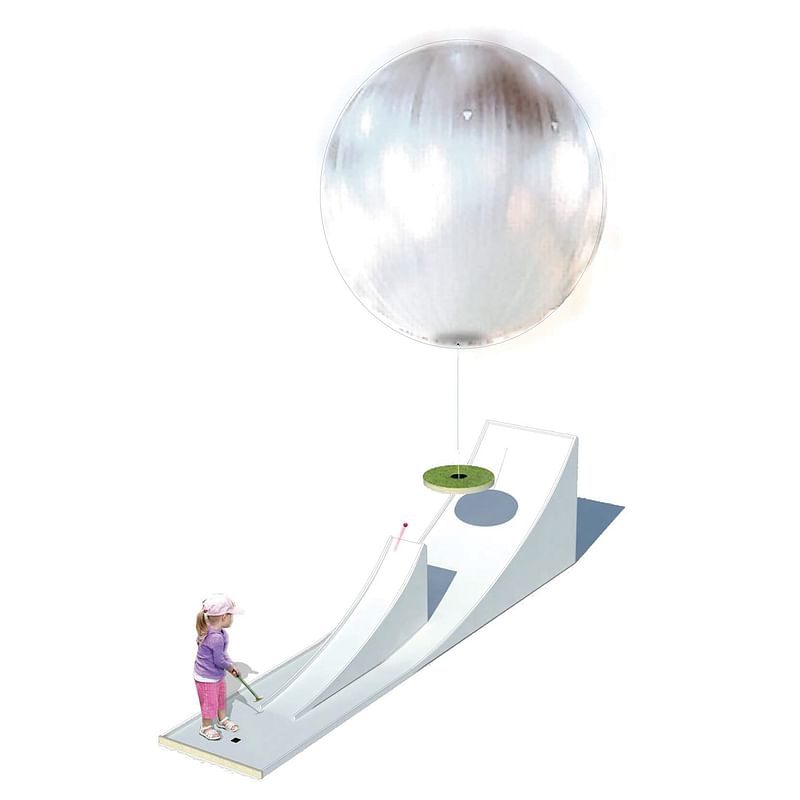
Pie in the Sky
by Heyday Partnership (Patrick Fromm, Devyn Miska, Cristiano Teixeira, Kevin Wronske)
"This hole represents the impossible dreams of having turf in this climate. The idea is that to maintain even a very small amount of green grass requires a set of conditions and resources- from clouds to wind to water - that LA simply does not have. The actual golf hole and a small amount of turf are suspended from a mylar balloon that sways in the wind. The player putts their ball, attempting to hit a ramp, which launches their ball into the floating hole. If your ball lands on the target, it goes in the hole and you’re done. If you miss, the backdrop is sloped back to the player so the ball returns to the player to try again. Aside from all the turf talk, how fun would a floating putt-putt hole be?"

Artificial Turf
by G!LL!S (Matthew Gillis)
"The design introduces an undulating mirrored plastic terrain, deforming one’s location or turf into abstract image field. The project seeks an escape from the traditional tropes of mini-golf obstacles, by attempting to draw out an absence of object and a presence of effect. By bringing the sky to the ground, the ceiling to floor, and the grass underneath, the project aims to turn the mini-golf fairway into a visual rich field with an every changing reading. While a ‘hole in one’ will make the experience quick and short, and important for those keeping score, The fairway is actual a field with two directions to strike the ball, it also has with a feedback loop to avoid having the end the game all together. A constant shifting between foreground and back- ground, figure and color, fixed and mobile defines a new territory for reading the city or ways of playing the mini-golf on Artificial Turf.
Mirrored or reflected surfaces on a ground plan immediately disrupt a context, while simultaneously being constructed by its imagery. These surfaces present an identical space yet on the other side of the looking glass; foreign, removed, estranged. But if the reflected surface becomes distorted and unflattened, the abstract imagery becomes counter-intuitively more accessible and comfortable as visual stimuli to participate with or have a background.
Artificial Turf can be utilized in two different way increasing the variety of possible paths and understanding of the 'turf' in the city. The fairways offer a final hole that can deposit the balls into a repository at the end of game, though if not successful from the first put the ball will return itself either back down the fairway or through a channel until you make."
All images courtesy of Materials & Applications.
Click through the thumbnails to see the honorable mentions.
Honorable Mention (not pictured): "On Par" by David Eskenazi & Mark Acciari

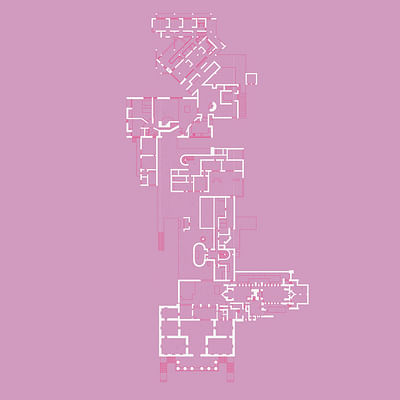
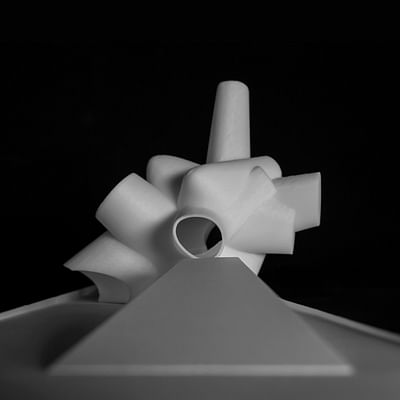



Share
0 Comments
Comment as :